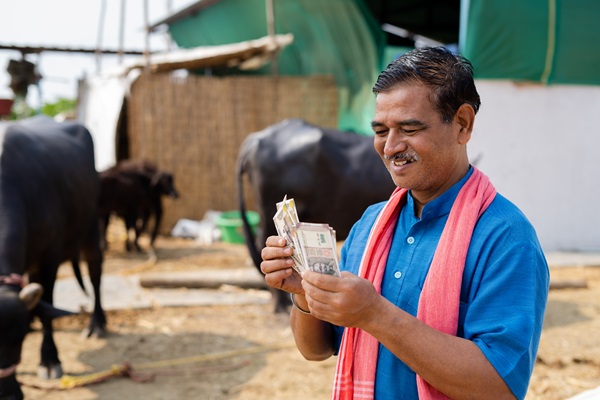.png)

Dr Arun Kumar is a Professor of Finance at IIT Madras, with interests spanning microfinance, corporate governance, and development finance.
May 11, 2025 at 9:59 AM IST
The Self-Help Group Bank Linkage Programme has emerged as India's largest microfinance initiative, playing a pivotal role in promoting financial inclusion by reaching 178 million rural households. In 2023-24, loans of ₹2.09 trillion were disbursed to 5.48 million self-help groups, marking a 28% increase in the number of self-help groups and a 44% rise in disbursement value from the preceding year. The total outstanding loan portfolio stood at ₹2.60 trillion across 7.74 million self-help groups, with an average loan size of ₹380,000 per self-help group, indicating enhanced financial engagement and credit absorption.
The programme maintained a low non-performing asset ratio of 2%, reflecting a 27% improvement over the previous year and demonstrating strong credit discipline among self-help group members. The sector has also witnessed a significant growth, driven by microfinance institutions. The gross loan portfolio in microfinance as of 2023-24 was ₹4.34 trillion, an 8.8% increase from ₹3.99 trillion a year before. This figure is projected to grow further in 2024-25.
Microfinance institutions have played a significant role in this expansion, accounting for ₹1.42 trillion, or 40.6%, of the total industry portfolio. The number of unique borrowers reached 78 million, served through 132 million loan accounts. These figures reflect the sector's critical role in financial inclusion, especially among underserved populations. As of September 2024, the microfinance industry reported an outstanding portfolio of ₹3.74 trillion, encompassing 126.5 million active loan accounts and reaching 77 million unique live borrowers.
A significant portion of this growth is concentrated in the 112 Aspirational Districts designated by NITI Aayog, which together accounted for an outstanding portfolio of ₹527.03 billion as of September 2024, registering a 7% growth from a year before.
However, this rapid expansion brings concerns.
The key indicator of delinquency of loans--accounts more than 90 days overdue--has risen sharply. It increased from 0.90% in September 2023 to 1.34% in June 2024, and further to 2.30% by the end of September 2024. This uptick suggests growing repayment challenges and highlights the urgent need for robust credit quality monitoring. For example, North 24 Parganas in West Bengal, an aspirational district with the highest portfolio growth, registered a 25% increase in outstanding loans. Thanjavur, a top-performing district by volume, recorded the highest 90-day delinquency rate as of September 2024.
Such spikes in delinquencies raise questions about repayment behaviour and the nature of credit usage. The relative ease of accessing credit, combined with regulatory changes, has contributed to this. The Reserve Bank of India’s revised guidelines, which increased the threshold for classifying a loan as microfinance to ₹300,000, have effectively raised the average loan size, contributing to higher delinquencies.
According to the RBI’s Regulatory Framework for Microfinance Loans, at least 50% of microfinance lending must be for income-generating activities such as small businesses and agriculture. However, this target is increasingly under threat. A recent SIDBI-
Equifax Microfinance Pulse report revealed that only 54% of loan end-use disclosures were linked to productive purposes, while 46% were directed to consumption smoothing.
TransUnion CIBIL Microfinance report further highlights that 35-40% of new-to-credit borrowers with loans under ₹50,000 used funds for personal or household consumption. This trend is particularly prevalent in urban and peri-urban areas, where non-income-generating loan usage has grown at an annual rate of 22%.
Microfinance is mirroring broader trends in the financial ecosystem, particularly the surge in unsecured personal loans and "Buy Now, Pay Later" schemes, which are growing at 28-30% year-on-year. Alarmingly, many borrowers who opt for such products also have active microfinance loans. This indicates a growing reliance on multiple credit lines to fund aspirational consumption, on items like smartphones, electronics, and lifestyle products.
For borrowers with irregular incomes and unstable cash flows, this trend risks pushing them into a debt trap. The shift from entrepreneurship-oriented to consumption-oriented borrowing undermines the long-term sustainability of the microfinance model and its goal of economic empowerment. There is a pressing need for enhanced financial literacy programmes and stricter enforcement of lending norms to ensure loans are used productively.
The RBI has warned that this consumption-led borrowing poses a serious risk to asset quality of microfinance institutions and small finance banks that cater to low-income households. The impact is clear in asset-quality metrics. According to Equifax Microfinance Trends, the portfolio at risk beyond 30 days is 6.8% for non-income-generating loans, more than double the 3.2% for income-generating loans.
These shifts raise critical concerns about the sustainability and original mission of microfinance. Going forward, microfinance programmes must re-emphasise microenterprise-linked initiatives that lead to sustained income generation and diversification. While borrowers may benefit from lower interest rates, these savings do not necessarily translate into long-term financial stability.
Expanding financial literacy, particularly among first-time borrowers, can help reduce over-indebtedness and improve loan outcomes. The sector also needs to evolve from being a standalone credit provider to one that includes credit-plus components, such as livelihood support, skill-building, and financial planning. A comprehensive strategy that blends income and consumption smoothing, while discouraging consumption of luxury goods, is essential.




